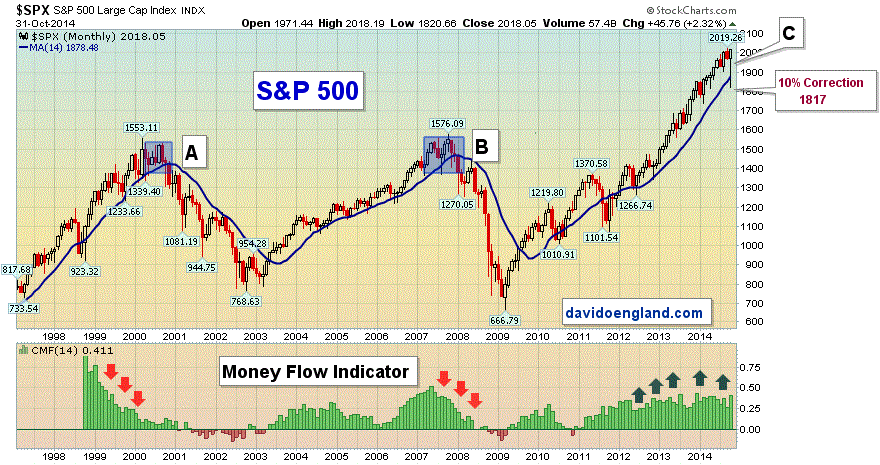Last week, we analyzed my weekly S&P 500 chart and saw my system signaled lower prices ahead, but missed a 10 percent correction by .17 percent. After the selloff, the markets have rebounded. Today we will look for clues to help answer, “Using your long term system, is it time to sell and head to the hills?”
To answer, I will use one of my systems, highly effective at giving profitable (buy and sell) signals. Again, nothing is 100 percent. Let’s take a look at a 20-year monthly chart of the S&P 500 and see if my long term-system is giving sell signals, spotting a major downturn ahead.

Per the chart, my trading sell signals are hit when two conditions occur. First, the price must cross down through the blue signal line and stay under this line by the end of the next month. If this happens and the money flow indicator (bottom box) is signaling money flowing out of the market, then we have a system sell signal. Many wished they would have been out of the market during these huge downturns (point A) from 2000-03 and also (point B) from 2007-09.
Quiz time. Are there current sell signals (point C) for the S&P 500? The price is trading well above the blue signal line plus the money flow is still extremely positive. Use the previous rules to determine the answer to this week’s question.
Although painful for some, a pullback of 10 to 15 percent would be healthy for the market. Per my chart, a 10 percent pullback from the recent (2019) high would take the S&P 500 to 1817, well below my blue signal line at 1874. Speaking of the signal line, all investors should know how to determine a signal line for each and every security in their portfolio—especially if they are close to retirement. You can see it is possible to have one as an investment tool. Do you have a signal line for each of your securities? If not, why?
A final point. Per the previous market tops (points A & B), the previous topping action took several months to form. Currently, (point C) we have not had the same multi-month sideways action. Barring an exogenous event (that I pray does not happen) and as long as the GDP does not drop or corporate profits do not fall off a cliff, I see continued upside sprinkled with selling like what we experienced a few weeks ago. If I start to see multi-month sideways action similar to points A & B, I will be extra cautious about adding non-dividend positions to my portfolio.
I have taught many these simple systems--you can learn as well.
Plan your work, work your plan and learn to share your harvest!
David England is the award-winning educator, Wall-Street loves to hate.
To discover why, visit his website at davidoengland.com.
